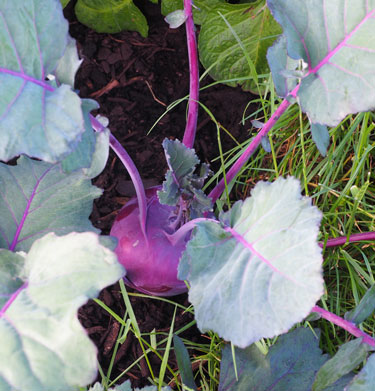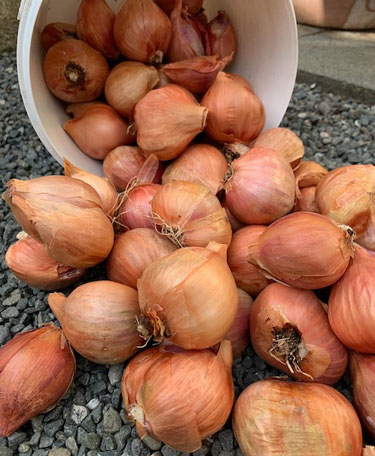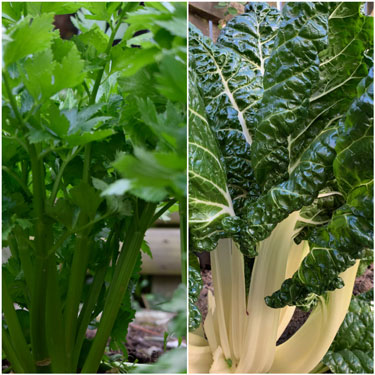Planting a winter garden
Where frosts come early, wise gardeners have already planted their brassicas, but in most gardens there is still time to plant cauliflower, cabbage or broccoli seedlings, or sow some seeds. Some gardeners sow directly into garden soil that is still warm from summer. Sowing in trays of seed raising mix for transplanting out later is the easiest option for most of us, and it ’s a good plan if you are waiting for late summer harvests to free up space.
Tomato plants will keep producing until the first frosts, but fortunately they’ll continue to ripen after picking. Pumpkins, however, must be left on their vine until fully ripe. They are ready for harvest when they have good colour and the vine begins to die off. Another test for ripeness is to gently knock them with your knuckles; a ripe pumpkin sounds hollow and has hard skin resistant to denting.
Chillis can be preserved dried or in jars or frozen for future use. Aubergines can be frozen in dips or pasta sauces and will keep for up to two weeks in the fridge.
What to plant in Autumn
A quick crop of dwarf beans, radishes or salad greens makes good use of space where March and April remains warm and summery, filling the gaps between slower growing brassicas. You might also plant some herbs or salad veges in containers.
Brussels sprouts are cool-climate treats well-worth growing if your winter is cold enough, but get them in soon. Plant Brussels sprouts where they have some shelter from strong winds, as they are tall and shallow rooted.
Cauliflower grows best in temperatures between 15 and 20°C. When it’s too hot the curds may be loose and plants may bolt, so in warmer climates, the ideal planting season is late summer and autumn. This gives young seedlings the warm conditions they need to get started in life, with cooler weather as the cauliflowers mature. Recently, however, new heat tolerant cauliflowers have been introduced which will make planting time less critical. Most varieties are ready for picking about 4 months after planting. In a warm climate, planting a batch of seedlings each month in March, April and May should keep you in cauliflowers from June through till spring.
Cabbage, Broccoli and Kale are easier to grow than their cauliflower cousins, but they enjoy the same conditions. Sprouting broccoli will keep producing succulent side shoots well after the main head has been picked. There is no doubt that home grown broccoli is a whole lot tastier, darker green and more nutrient dense than shop bought broccoli.
Kohlrabi, another member of the brassica family is easy to grow and tastes like a mild, sweet turnip. The bulb is delicious in slaws and salads or roasted in the oven. Kholrabi stems and leaves are edible too. There are both purple and green varieties.
Beetroot is best sown directly into the soil and is an ideal vege to harvest over the winter months. In warmer climates sow anytime from August right through to March. In coldest climates beetroot is best sown in spring for autumn harvest.
Carrots can be still be sown throughout the North Island in autumn. For a continuous supply sow carrots every 3-4 weeks. Carrots survive light frosts once growing, but sow your last batch of seed 2-3 months before heavy frost. In the colder south it’s best to delay sowing until spring.
The onion family includes lots of interesting varieties, including leeks, shallots and spring onions. Plant seedlings or sow seed directly into the soil in autumn. Garlic, traditionally planted on the shortest day and harvested on the longest, can be planted successfully from April onwards.
Spinach grows best with cool, moist roots, good drainage and plenty of compost and fertiliser. Winter grown spinach is especially sweet. Choose a winter variety.
Silver beet is easy to grow for picking all year round in mild climates, and for at least six months in colder climates. A great crop for winter it thrives with ample moisture and likes fertilisers high in nitrogen, such as blood and bone.
Broad beans are ready for picking three to five months after sowing. In windy areas these tall growing plants need some kind of frame or stakes and string for support
Peas are grown from seed sown directly into the soil. Sowing is timed to provide the cool soil needed for germination while avoiding frosty or hot dry weather during flowering time. This translates to autumn sowing for warmer climates, and spring sowing for colder climates. Always buy fresh seed to avoid disappointment. Avoid direct contact with fertilisers.
Celery dislikes temperature extremes. In a warm climate autumn planting avoids the heat of summer. In cold climates it is best to plant celery in spring. It will grow in part shade and thrives in moist but well-drained soils with lots of compost and manure. Sheep pellets are ideal. Celery is a fantastic vegetable to have on hand for soups and casseroles and dark green celery is great for cooking. If you want to grow it to eat raw, the stems are sweeter when ‘blanched’. This involves blocking the light, easily done by wrapping the stems with newspaper 2-3 weeks prior to harvesting.
Success with brassicas
- Choose a sunny position with well drained soil.
- Avoid planting in soil that recently grew brassicas (the longer between crops the better).
- Dig in compost and fertiliser before planting.
- Add some lime to ‘sweeten’ the soil.
- Protect plants from white butterfly caterpillar. Use insect mesh to prevent white butterfly laying eggs on brassicas.
Tip: Feed seedlings with seaweed solution for strong healthy roots.
Fun fact: Broccoli is basically a cabbage with edible shoots - what we eat is a bouquet of flower buds. When it first made its way to England they called it ‘Italian asparagus’. If you peel and eat the nutritious stalks the likeness is easy to appreciate.

1-Mar-2022

The 'big four' - broccoli, Brussels sprouts, caulifower and cabbage - essential winter veges.

Curly kale

Kohl rabi

Shallots

Celery and Silver beet

Insect netting protects brassica seedlings from white butterflies

